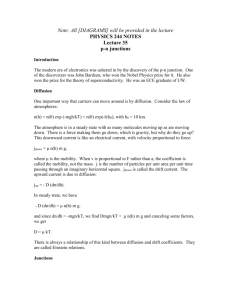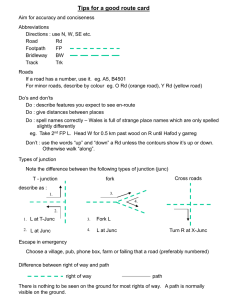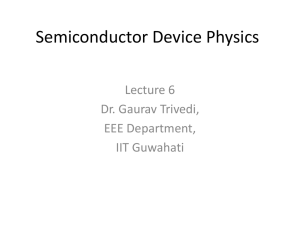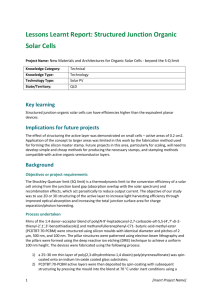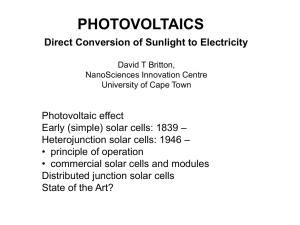Solar_Cell_Review
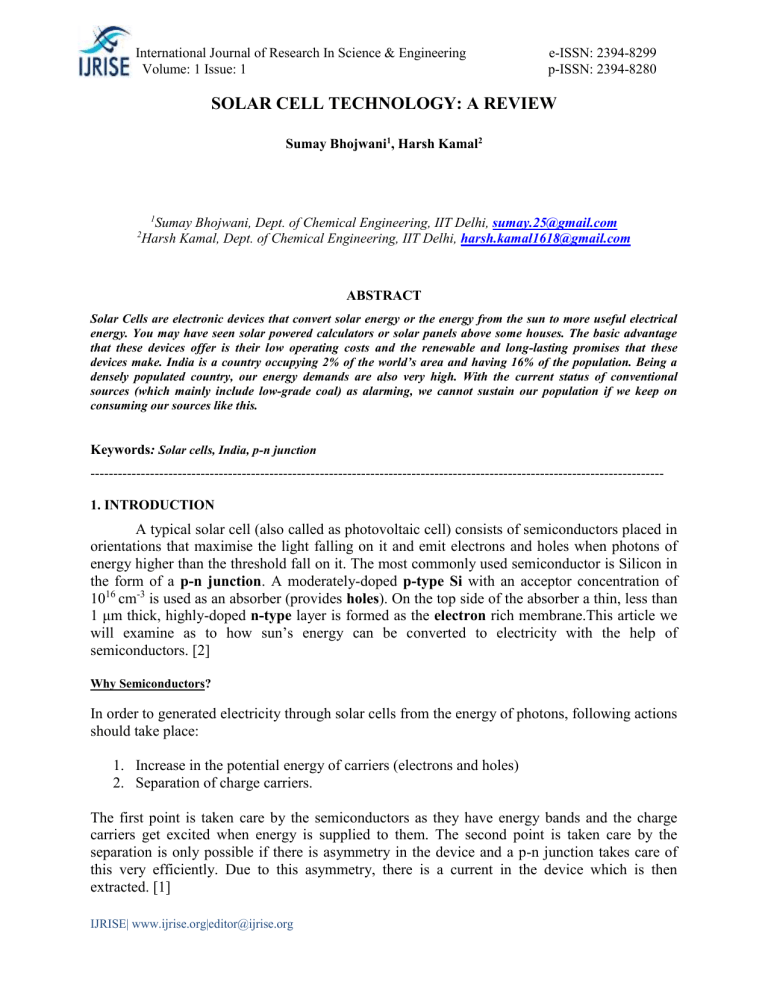
International Journal of Research In Science & Engineering
Volume: 1 Issue: 1 e-ISSN: 2394-8299 p-ISSN: 2394-8280
SOLAR CELL TECHNOLOGY: A REVIEW
Sumay Bhojwani 1 , Harsh Kamal 2
1
Sumay Bhojwani, Dept. of Chemical Engineering, IIT Delhi, sumay.25@gmail.com
2 Harsh Kamal, Dept. of Chemical Engineering, IIT Delhi, harsh.kamal1618@gmail.com
ABSTRACT
Solar Cells are electronic devices that convert solar energy or the energy from the sun to more useful electrical energy. You may have seen solar powered calculators or solar panels above some houses. The basic advantage that these devices offer is their low operating costs and the renewable and long-lasting promises that these devices make. India is a country occupying 2% of the world’s area and having 16% of the population. Being a densely populated country, our energy demands are also very high. With the current status of conventional sources (which mainly include low-grade coal) as alarming, we cannot sustain our population if we keep on consuming our sources like this.
Keywords: Solar cells, India, p-n junction
-----------------------------------------------------------------------------------------------------------------------------
1. INTRODUCTION
A typical solar cell (also called as photovoltaic cell) consists of semiconductors placed in orientations that maximise the light falling on it and emit electrons and holes when photons of energy higher than the threshold fall on it. The most commonly used semiconductor is Silicon in the form of a p-n junction . A moderately-doped p-type Si with an acceptor concentration of
10
16 cm
-3
is used as an absorber (provides holes ). On the top side of the absorber a thin, less than
1 μm thick, highly-doped n-type layer is formed as the electron rich membrane.This article we will examine as to how sun’s energy can be converted to electricity with the help of semiconductors. [2]
Why Semiconductors?
In order to generated electricity through solar cells from the energy of photons, following actions should take place:
1.
Increase in the potential energy of carriers (electrons and holes)
2.
Separation of charge carriers.
The first point is taken care by the semiconductors as they have energy bands and the charge carriers get excited when energy is supplied to them. The second point is taken care by the separation is only possible if there is asymmetry in the device and a p-n junction takes care of this very efficiently. Due to this asymmetry, there is a current in the device which is then extracted. [1]
IJRISE| www.ijrise.org|editor@ijrise.org
International Journal of Research In Science & Engineering
Volume: 1 Issue: 1 e-ISSN: 2394-8299 p-ISSN: 2394-8280
To understand how p-n junction behaves on application of light, we first have to see how an unbiased/equilibrium junction works and then progress towards the behaviour of junction under the application of light.
2. P-N JUNCTION WITHOUT ILLUMINATION
2.1 Unbiased p-n Junction
In an unbiased p-n junction, electrons are majority charge carriers in the n-side and holes at the p-side. There is thus a diffusion of electrons from n-side to p-side and vice versa. Also, due to holes (being represented with a positive sign) at the p side and majority of electrons being at the n-side, there is an electric field which points from n side to p. This electric field (called barrier field ) opposes the motion of the diffusion of electrons ( diffusion current ) and thus we reach equilibrium when this field is just about sufficient to prevent diffusion. This is characteristic of an unbiased p-n junction . The drift current due to barrier potential is equal and opposite to the diffusion current. Since the holes and electrons consume each other up near the junction due to their diffusion, we have a depletion region in the middle. A potential barrier is generated due to the motion of electrons and holes and is called built-in potential .
The schematic of an unbiased p-n junction is shown below:
Fig-1: Charge carrier concentrations in an unbiased solar cell (at equilibrium) [1]
2.2 Biased p-n Junction
When a battery is connected to the p-n junction, the junction is said to be biased. It can be either forward or backward. In case of forward junction, positive pole of the battery is connected to the p side. In case of reverse bias, the positive is joined with n-side.
Forward Biased p-n junction
For forward bias p-n junction, the size of the barrier is reduced attributing to the fact that the applied electric field opposes the already existing built-in potential. The reduction in the height of the barrier causes the current to flow since now the barrier field is insufficient to control the current flow. The reduction in the barrier height eases the diffusion of electrons from one side to the other and thus the diffusion current rises. At the same time, the drift current remains unchanged owing to the insignificant change in the barrier field (depends on the material and
IJRISE| www.ijrise.org|editor@ijrise.org
International Journal of Research In Science & Engineering
Volume: 1 Issue: 1 e-ISSN: 2394-8299 p-ISSN: 2394-8280 doping levels). Thus the no of minority carriers swept across the junction (drift current) is negligible as compared to the majority carrier diffusion (diffusion current).
[3]
For carrier concentration profile, due to diffusion of majority charge carriers, we see an increase in the minority concentration on the other side. Also, to maintain electrical neutrality in the quasi-neutral region, we see a similar rise in the concentration of majority carriers.
Fig-2: Carrier Concentrations for forward-bias p-n junction. [1]
Reverse Biased p-n junction
In reverse bias, the voltage applied is such that the electric field at the junction increases. The higher electric field causes decrease in diffusion current. The drift current again remains unchanged but rises by a very small amount owing to the increase in width of depletion region.
In all, the current in case of reverse bias is negligible and is called reverse saturation current (Is).
This reverse saturation current is practically independent of the applied reverse bias but depends on the temperature of the diode. This is because the minority carrier density contributing to Is increases with a rise of temperature. [3]
3. P-N JUNCTION UNDER ILLUMINATION
When light falls on p-n junction diode, electron-hole pairs are generated. If the wavelength is such that it is weakly absorbed by the material, then the generation rate of electron hole pairs will take place uniformly. This generation takes place in the space-charge as well as in the quasineutral region. The carriers generated in the space-charge region are immediately swept away due to electric field (electrons towards n-side and holes towards p-side). Some carriers generated in the quasi-neutral region wander off and cross to reach the space-charge region. Note that only the minority carriers are able to cross the junction from n to p and vice versa. This is because they can afford to go down the hill in terms of energy. Majority carriers cannot rise up the energy level so their contribution is almost zero. In this way, holes from n-side come to p-side (leaving behind a negative charge) and electrons from p-side come to n-side (leaving behind a positive charge). So, we can see a net increase in positive charges in the p-side and negative charges in the n-side. A potential is thus developed across the p-n junction due to light falling on it. This generation of photo voltage is called the photovoltaic effect.
[1]
IJRISE| www.ijrise.org|editor@ijrise.org
International Journal of Research In Science & Engineering
Volume: 1 Issue: 1 e-ISSN: 2394-8299 p-ISSN: 2394-8280
Fig-3: p-n junction diode under illumination. The electrons are represented by filled circles and the holes are represented by empty circles.
The carriers generated in the quasi-neutral region travel an average distance known as Diffusion
Length [ Lp (for holes) or Ln (for electrons)] before they recombine with an opposite type of carrier. So, we can say that those carriers generated within the diffusion length will only cross to reach the space-charge region and thus have some contribution to the photocurrent.
The rate of minority carrier generation depends on the intensity of light . Generally, minority carrier concentration increases largely while the majority carrier generation is not that affected by the light incident on the semiconductor. If we talk about the carrier profile for an illuminated p-n junction, we find that those carriers in the space charge region are immediately diffused to the other side so the minority carrier concentration is equal to the equilibrium concentration. The majority carrier concentration is almost unaffected in a particular side (n or p). The carrier concentration decreases as we approach the junction as they get drifted away to the other side and thus increasing the majority carrier concentration on the other side. (for example: holes at pside, being the majority ones, remain unaffected and electron concentration first decreases near the p-n junction and then rises sharply as we move to the n-side, being the majority carrier in the n-side.)
Fig-4: Minority and Majority Carrier Profile in an Illuminated p-n junction. [1]
IJRISE| www.ijrise.org|editor@ijrise.org
International Journal of Research In Science & Engineering
Volume: 1 Issue: 1
3.1 Light Generated Current e-ISSN: 2394-8299 p-ISSN: 2394-8280
Due to the drift of electron from p-side to n-side and vice-versa, we have a light generated current I
L
. The generated photocurrent biases the p-n junction in a forward bias mode i.e. it reduces the junction’s potential energy barrier and due to this, there is a diffusion of majority carriers from one side to the other. So, the diffusion current flows in a direction opposite to the light generated current. But, since the magnitude of light generated current is larger than the diffusion current, we have a net current flowing from n-side to p-side (opposite to that of forward bias case). This causes the graph to shift downwards. So, according to the curve, the current is negative and the voltage is positive. This implies negative power, which means that power is being extracted from this device. [4]
Here, I
L
is the light generated current, which indicates that the carriers generated within the volume of cross-sectional area A and length (Ln + Lp + W) contributes to the IL. The total current for the illuminated solar cell across the junction is given by:
The first term here accounts for the forward biased current that gets established because of the diffusion and drift effects due to the reduced potential barrier.
3.2 Solar Cell Parameters
The four parameters generally used for solar cell characterisation are: Short Circuit Current
(I sc
), Open circuit Voltage (V oc
), Fill Factor (FF) and efficiency.
The figure below shows the
I-V relation keeping in mind that the current axis is actually a negative axis. [1]
Fig-5: Typical plot of I-V relation for a solar cell and its parameters
Short Circuit Current: This is the maximum current that flows inside a solar cell when its terminals (n-side and p-side) are shorted with each other (V=0). We get I sc
= -I
L
. So, in terms of magnitude, short circuit current equals light generated current.
IJRISE| www.ijrise.org|editor@ijrise.org
International Journal of Research In Science & Engineering
Volume: 1 Issue: 1 e-ISSN: 2394-8299 p-ISSN: 2394-8280
Open Voltage Current : It is the maximum generated potential when the ends of the junction are kept open (I=0). Using the equation for light generated current, we get:
So, we can say that the open voltage current depends both on reverse saturation current and light generated current.
Fill Factor: Ratio of maximum power (P m
= V m
X I m
) to the ideal power (P
0
= V oc X
I sc
). It is a measure of the square-ness of the I-V curve.
Efficiency: Ratio of Power output to the Power input. Input power is equal to the irradiation received on the earth’s surface, P rad
. According to the Internationalstandard for Characterization of Solar Cells, P rad is equal to 100 mW/cm
2
or 1000W/m
2
.
4. NEED FOR SOLAR POWER IN INDIA
India is a country occupying 2% of the world’s area and having 16% of the population. Being a densely populated country, our energy demands are also very high. With the current status of conventional sources (which mainly include low-grade coal) as alarming, we cannot sustain our population if we keep on consuming our sources like this. There is a dire need for solar power to come to a tropical country like India where the potential is huge. We currently produce less than
1% of what we consume through solar power as compared to countries like Germany and France which produces 18% of its power through it. For a country like India where bulk imports of fuel are neither affordable nor strategically advisable, it is our responsibility to make this nation move towards sustainable and long-lasting sources and make this country both liveable and economically strong. [5]
Solar power has so far played a non-existent role in the Indian energy scenario. The gridconnected capacity in India now stands at 481.48 MW (as of Jan 31st 2012). However, the market is set to grow significantly in the next ten years. This is mainly because of the load being handled by the non-renewable sources and their limited availability. The rise of solar usage is not
IJRISE| www.ijrise.org|editor@ijrise.org
International Journal of Research In Science & Engineering
Volume: 1 Issue: 1 much because of they long payback times and high installation costs. e-ISSN: 2394-8299 p-ISSN: 2394-8280
The Indian Government has begun to acknowledge the importance of solar energy and thus launched a National Solar Mission in 2010. There are also subsidies being provided by the government for solar installations to combat the high installation costs incurred. Across India, there are still thousands of villages with plenty of sun but not enough power. [5]
REFERENCES
[1] Chetan Singh Solanki, “Solar Photovoltaics : Fundamentals, Technologies and Applications”, PHI Learning
Pvt. Ltd., 2011, pp. 70-94
[2]
Jessika Toothman and Scott Aldous, How Solar Cells Work, Received from “science.howstuffworks.com/ environmental/energy/solar-cell.htm”
[3]
[4]
[5]
Christiana Honsberg and Stuart Bowden, Received from ” pveducation.org/pvcdrom/solar-cell-operation/solarcell-structure”
Physics.org, How Solar Cells Work, Received from www.physics.org/article-questions.asp
Swami Prakash Srivastava and Surat Prakash Srivastava, Solar Energy and its future role in Indian Economy,
Received from “www.ripublication.com/ijesdmspl/ijesdmv4n3_18.pdf”
IJRISE| www.ijrise.org|editor@ijrise.org


